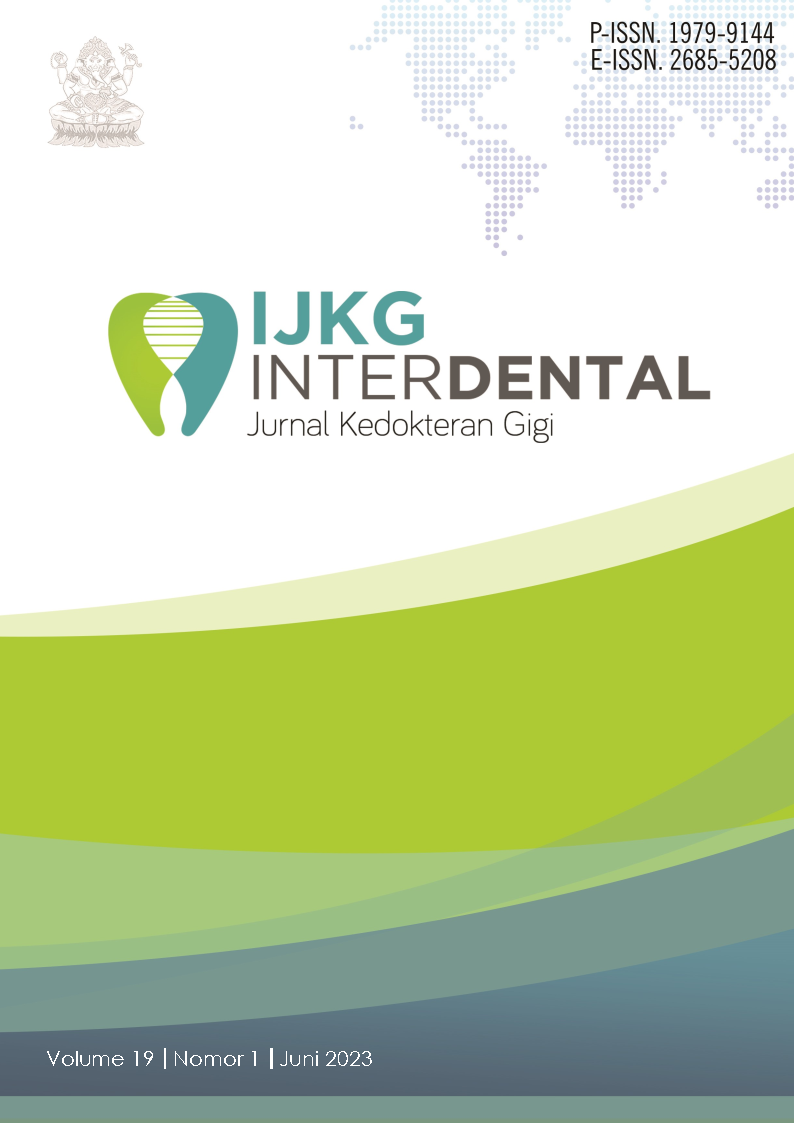CORRELATION OF MOUTH BREATHING HABITS TO DENTAL MALOCCLUSIONS
KORELASI KEBIASAAN BERNAPAS MELALUI MULUT TERHADAP JENIS MALOKLUSI GIGI
DOI:
https://doi.org/10.46862/interdental.v19i1.6318Keywords:
Mouth breathing habit, type of malocclusionAbstract
Introduction: one of the malocclusion’s etiology is bad habits such as mouth breathing habit. The purpose of this study was to determine the relationship between the mouth breathing habit through with the type of malocclusion. Materials and Method: the sampling method used was purposive sampling obtained from giving questionnaires to parents and clinical examination of the oral cavity of students at SDN 17 Dauh Puri Denpasar. The number of samples with mouth breathing habit were 50 samples. Classification of dentition malocclusion in students was assessed using a modified Dewey Angle Classification. Data analysis used the chi-square test. Results and Discussion: the results of this study were that the mouth breathing habit was more dominant in the Class I Angle type 2 Dewey malocclusion with a total of 25 students (50%) and in the Class I Angle type 4 Dewey malocclusion with a total of 14 students (28%). Conclusion: the conclusion of this study is that there is a significant relationship between the mouth breathing habit and the type of malocclusion.
Downloads
References
Septuagina AA, Kepel BJ, Anindita PS. Gambaran oral habit pada murid SD Katolik II ST. Antonius Pulu. Jurnal e-GIGI. 2013; 1(1): 18-27.
Proffit WR, Fields HW, Sarver DM. Contemporary Orthodontics. 4th ed. St Louis: Mosby Elsevier; 2007. h. 231-7.
Nabila RC, Primarti, RS, Ahmad I. Hubungan pengetahuan orang tua dengan kondisi maloklusi pada anak yang memiliki kebiasaan buruk oral. J Syiah Kuala Dent Soc. 2017; 2(1): 12-8.
Shahraki N, Yassaei S, Moghadam MG. Abnormal oral habits: A review. Journal of Dentistry and Oral Hygiene. 2012; 4(2): 12-5.
Shah FA, Batra M, Sudeep, Gupta M, Kadambarildhok, Kumar R. Oral habits and their implication implicaton. Annuals Medicus. 2014, 1(1): 179-86.
Phulari. Orthodontics Principles and Practice, 1st ed. Jaypee Brothers Medical Publishers, India; 2011. p. 73-9.
Elianora D. Pemeriksaan lengkap kebiasaan buruk mengisap ibu jari (Thumb Sucking) - laporan kasus. Jurnal B-Dent. 2014; 1(2): 102-11.
Motta JL, Almeida T, Marangoni AF, Mesquita-Ferrari RA, Fernandes KPS, Bussadori SK. Gender as Risk Factor for Mouth Breathing and Other Harmful Oral Habits in Preschoolers. Brazil Journal of Oral Sciences. 2012; 11(3): 377-80.
Rahardjo P. Ortodonti Dasar, 2nd ed. Pusat Penerbit dan Percetakan Unair (AUP), Surabaya; 2009. p. 25-32.
Foster TD. Buku Ajar Ortodonsi, Penerjemah: Lilian Yuwono, 3rd ed. EGC, Jakarta; 2012. p. 33-9.
Mitchell L. An Introduction to Orthodontics, 3rd ed. Oxford University Press, Inc, New York; 2007. p. 114-8.
Singh G. Textbook of orthodontics, 2nd ed. Gopsons Papers Ltd, Noida; 2007. p. 88-93
Lagana G, Fabi F, Abazi Y, Natasi .B, Vinjolli E, Cozza P. Oral habits in a population of Albanian growing subjects. European Journal of Paediatric Dentistry. 2013; 14,(4): p. 309-13.
Joelijanto R. Maloklusi yang terjadi pada kebiasaan buruk anak. IDJ. 2012; 1(2): p. 86-92.
Souki BQ, Pimenta GB, Souki MQ, Franco LP, Becker HM, Pinto JA. Prevalence of malocclusion among mouth breathing children: do expectations meet reality?. Int J Pediatr Otorhinolaryngol. 2009; 73(5): p. 767-73.
Kusuma ARP. Bernafas lewat mulut sebagai faktor ekstrinsik etiologi maloklusi. Majalah Ilmiah Sultan Agung. 2010; 48(1): 12-31.
Downloads
Published
How to Cite
Issue
Section
License
- Every manuscript submitted to must observe the policy and terms set by the Interdental Jurnal Kedokteran Gigi (IJKG)
- Publication rights to manuscript content published by the Interdental Jurnal Kedokteran Gigi (IJKG) is owned by the journal with the consent and approval of the author(s) concerned.
- Full texts of electronically published manuscripts can be accessed free of charge and used according to the license shown below.













